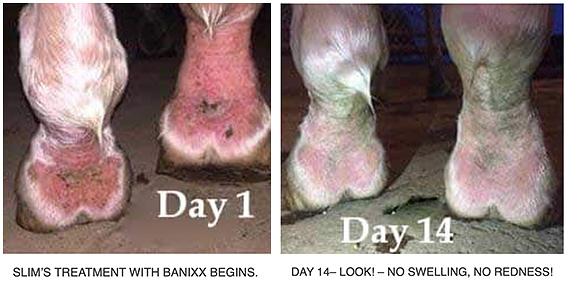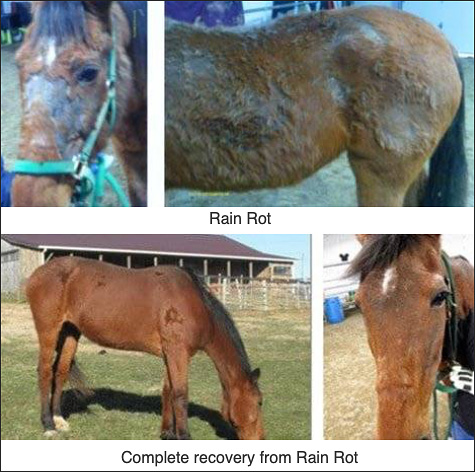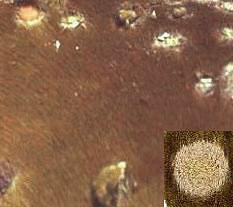 |
 |
|
How To Help Horses with Skin Problems
This article was written so you will be well informed to make the Best choices for Your Horse’s Well-being!
Article from Banixx Pet Care Products
Skin issues can be bacterial or fungal in nature, but sometimes, there is an underlying cause; that's what's behind the scenes, and
uncovering the reason may be more complicated. But, let's not get ahead of ourselves. If the problem IS simply bacterial or fungal, and
you may need a Veterinarian to determine this, then there is a large selection of products on the market to address these issues.
However, do your research. Some products are unnecessarily expensive. Then, some are too cheap and often contain ingredients that
are not pleasant for your horse, such as alcohol, which will burn your horse’s skin. And don’t go the cheap route, such as hydrogen
peroxide, which is known to harm healthy tissue! There are enough trusted brands, so pick a quality one for Your Horse…your Friend!
Most common bacterial or fungal infections include the following:
Scratches (also called Mud Fever, Dew Poisoning, Greasy Heel, or Pastern Dermatitis)
Rain Rot (aka Rain Scald)
Ringworm
Sweet Itch
Girth Galls
Mites
And, not so common, Lice
 |
Horse Scratches are an escalating condition caused by a fungus: Sporotrichum Schenki. A season of cold rainy, muddy days or
mornings of early, heavy dew where seemingly, endless mud/moisture abound create the perfect storm for this pesky, persistent painful
problem. Other sources of irritation that may lead to Scratches include Insects and parasites that cause irritation and subsequent
infection: Dry, cracked skin that’s aggravated by the horse’s motion (notably the ankle area): Infection of the ankle/pastern hair follicles with Staphylococcal bacteria.
 |
Horse Rain Rot is caused by a bacterium called Dermatophilus congolensis. It's sometimes associated with poor horse care, but in
many cases, that is not the case; it's a cunning bacteria. These bacteria thrive on your horse's skin in warm, wet conditions, such as
spring or early summer. They multiply to the point that they irritate and infect a horse's skin hair follicles. Visually, rain rot looks like
scabby, scaly, or crusty skin along your horse's back and rump. In some cases, you'll see total hair loss.
 Horse Ringworm is also known as dermatophytosis. It's a fungal skin infection. Hair loss can
occur, and visually one sees a scaly, itchy, red rash in a circular pattern. Ringworm is a highly contagious skin fungus that can be spread from animal to human and human to animal. It is
more likely seen in animals with a weaker immune system, such as very young or older horses. Horse Ringworm is also known as dermatophytosis. It's a fungal skin infection. Hair loss can
occur, and visually one sees a scaly, itchy, red rash in a circular pattern. Ringworm is a highly contagious skin fungus that can be spread from animal to human and human to animal. It is
more likely seen in animals with a weaker immune system, such as very young or older horses.
Lice are a parasite. When lice infect your horse’s mane, tail, and lower legs, they are readily visible. It’s called pediculosis. Lice usually
infect sick, older, or horses with compromised immune systems. They are easily transmitted horse to horse via lice eggs and are of two
varieties: Sucking lice (eat blood) and Chewing lice (eat your horse’s dander).
Sweet Itch. Midges cause his annoying skin condition. Culicoides midges bite your horse anywhere from ears to tail. It's pretty
common to find them along your horse's centerline of his belly. Some horses are highly allergic and begin to itch wildly. Many will
scratch to the point of breaking the skin, and infection begins. It's a challenging infection. Antimicrobials can help. Some horse owners
resort to covering up their horse with special sweet itch sheets. Control your horse’s turnout time; midges are rampant at dawn and dusk.
Girth Galls: this describes a girth or saddle sore. They begin as a patch where you see some hair loss or raw skin. Any unwanted
friction between tack and skin can wear away the hair entirely, then sores or rashes appear.
This is generally an ill-fitting tack issue, so resolution is not complex with some tack changes. Girth covers work for some horses. It's good to check with your saddle fitter if the sores are higher up.
Mites: These attack your horse’s skin; they are too small for the naked eye to see. They feed on your horse’s skin, and she ends up
with mange. There are a few varieties. Chorioptic mites live around the horse’s legs. They make your horse incredibly itchy and
irritated. They are transmissible, but you are safe. Psoroptes mites create oozing sores and scabs. Your horse has an allergic reaction
to the mite poop. Your horse will probably lose its hair. Then, there are sarcopte mites that will transmit from horses to humans. When
they feed off your horse’s skin, the saliva creates hives and a mammoth thickening of the skin. It’s incredibly itchy and can lead to
further infection as your horse tries to relieve himself from the affliction. But, wait, there's more! There’s the demodex mite that resides
in hair follicles and can be found anywhere on your horse. Your horse’s skin achieves an unkempt, scaly appearance. Any mite infection calls for your Vet to be involved.
Well, that covers most of the easily detectable bacteria/fungi infections. All of these can be treated with a quality, trusted Horse Health
-Care product, although, as stated, some WILL also require Veterinary invention.
Now, we’ll move on to more complex issues such as:
Allergies
Cushing’s Disease
Poor body conditioning (including a parasitic worm infestation)
Horses with more pink-pigmented skin than their counterparts
Photosensitivity
For horses with Allergies, a simple blood test will reveal allergy triggers, and mostly, a course of allergy medication will control the
issue. But, be advised, IF the allergy medication is effective, then what follows is a multi-year commitment of monthly shots. These are
extremely easy for any horse owner to administer. I can personally attest that I have a horse who, at the age of 16, could hardly
breathe if worked during the entire period August to November. We agreed to allergy testing; he tested positive for several substances
. We bought and administered the allergy medication without any problems, and now, at almost 20, he is often mistaken for a far younger horse!
It’s also a good idea to experiment with different bedding, change up blanket materials and fly sprays (to deter biting insects) for an
allergy-prone horse. Of course, there are many other beddings – some are readily available, but most take a bit of work to locate and
can be more pricey than straight shavings. However, if your horse responds well, it's certainly worth it!
Cushing’s Disease: Again, a simple blood test will reveal this hormonal imbalance. Cushing’s disease results in the adrenal gland overly
increasing its supply of cortisol. This causes loss of muscle mass, amplified vulnerability to infection, and a long, shaggy hair coat.
Medication is readily available via your Vet that alleviates the issue, but this medication is a life-long commitment.
Poor body conditioning (including a parasitic worm infestation). This condition may result from inadequate dental care, a heavy internal
parasitic load, or old age. Involvement with your Vet is a good idea here. For example, you can do a fecal egg count. Large parasite
infections contribute to a dull coat in horses and less than optimum health. A quick dental exam by your Vet can reveal any dental
issues that are quickly resolved. Changing a feed formulated for an older horse may be in order.
For some reason, horses with more pink-pigmented skin than their counterparts have a much tougher time maintaining good skin health
. Consequently, if this is your horse, you have to be proactive. There is simply no way around it. Consider such defensive measures as
a protective, fitted, muslin-type fly sheet in summer. Or turnout only during the night-time hours in bug season or summer heat. Pay
careful attention to any healthcare products, shampoo, or spray products on your horse.
Photosensitivity. This almost exclusively affects pink skin, which lacks a dark pigment called melanin that protects against sunlight.
When a horse overeats forage containing high photodynamic qualities, they overwhelm her system and damage the skin when exposed
to the sun’s ultraviolet rays. Primary examples of the type of forage responsible for this are alfalfa, clover, and some pasture weeds.
As a result, your horse may develop blisters, sores, or rashes. It's a painful ailment!
So, how do You avoid skin problems and infections in Your Horse?
Stay on top of your horse's overall health. Manage his access to good, clean water at all times and provide a good source of good,
clean hay. Keep your horse fit! Allow as much time OUT of his stall for him as possible. Plan your time to give your horse a judicious
groom regularly. You'll be surprised how many problems you can avoid when you are more in touch with your horse's skin!
Be conscious of reading the ingredients when you buy products on your horse's skin. Banixx family of horse-care products fits the bill
nicely here. The Banixx antimicrobial Horse & Pet Spray delivers a mighty punch to bacteria and fungus and is also completely safe around the eye! Imagine that!
The Banixx Medicated Shampoo has been widely used on competition and trail horses with incredibly sensitive skin with resounding
success. This chlorhexidine-based shampoo contains NO soap but instead uses the highest quality, sudsy surfactants that seize the dirt
and grime from your horse's skin/coat without robbing him of his nature-given skin oils. Add to this that the shampoo is laden with
superior marine collagen to give your horse a dazzling, scintillating finish!
In need of some wound care Cream? Look no further than Banixx Wound Care Cream! It has a chlorhexidine base and is richly
enhanced with essential extracts such as Allow Vera, Eucalyptus, Chamomile, Oat Kernel Extract, Rosemary, Arnica, Calendula,
Coconut, and finally, Peppermint Oil. Several of these extracts are known for their avoidance of bugs! That's a good thing!
So, now you know! You're informed, and You can make the Best choices for Your Horse’s Well-being!
• How do you feel about detergents and shampoos? The key to a shiny horse is sebum! Over-shampooing strips all of that sebum
away. The healthy antimicrobial oil is gone, his hair is brittle, stains are glued in, and the shine is vaporized. This may contribute to skin issues!
• Plain ol’ dry skin is usually the culprit for dandruff. As a horse’s skin grows and sheds, dandruff may happen. It can be normal for a
horse, a sign that something else is wrong, or a result of an incomplete diet. Sometimes liver and other internal problems will create dandruff.
• You can find dry dandruff and oily dandruff. Oil dandruff may be the result of mites or lice.
• Depending on the cause of dandruff, you might need a special shampoo. Or a prescription for lice treatment. Or you are bumping up
your horse's diet to include more skin-healthy ingredients, like Omega-3 fatty acids.
• Anhidrosis is a skin disorder of horses and happens when a horse can't fully sweat or can't sweat at all. Yes, this isn't good and can quickly overheat a horse in the summer.
• So much about anhidrosis is a mystery. Sometimes it appears from the ether. Other times a horse can have it for years, and then he can sweat normally again.
• To help the horse with anhidrosis, exercise him when it’s coolest outside. Use alcohol sprays to help his body thermoregulate, and look into supplements and medications from your Vet.
Girth galls
Proud flesh
• Oh, what a proud nightmare flesh can be. This overgrowth of granulation tissue can quickly take over a horse's lower leg!
Granulation tissue is the blood-rich pink tissue that closes the edges of a wound and brings the skin back together. Proud flesh happens when that granulation tissue goes into a hyper-drive mode.
• Your veterinarian may need surgery for this, and caring for a wound with proud flesh is an investment of time and multiple veterinary interventions.
How to notice common skin conditions
• There is no better preventative for any problem than daily horse grooming. Curry combing is vital for keeping your horse’s natural
oils swirling around. Inspect every last inch of your horse in the process.
• Notice if your horse has rumpled hair from rubbing himself.
• Does he seem extra itchy as you are grooming him?
• Is he shedding naturally, or are there clumps of hair falling out?
• Does any part of your horse’s skin seem oilier, drier, scalier, or just different from the rest of his skin?
• Is he rubbing his mane or tail? Or both?
• What is the overall quality of his hair? Any changes or anything new?
The rest of skincare is just management.
•Remove blankets and fly sheets daily. This keeps you ahead of rubs and sores.
•Keep your horse’s bedding clean. Regular cleaning also helps with fly control.
•Clip your horse for his health, not for his looks. Sometimes, having a horse sweat in a winter coat creates infinitely more problems than not clipping him.
•Clipping certain affected areas help a problem area remain clean and dry. As a result, topical treatments and medications will also reach their destination more effectively!
•Work with your Vet to narrow down possible causes of any skin irritations you find. Early intervention saves you money and helps your horse heal much faster!
|
 |
 |
 |
 |
 |
|
To advertise your horse product or service, Contact Ann
|
|
|
|
InfoHorse.com, Horse Information Lives Here ®
5/3/2024
Contact Us to Advertise to over a million Horse Owners.
All images and content Copyright© 2022 by InfoHorse.com,
|
|
|
|
Articles, Academic Schools, Arena Maintenance, Animal Communicators, Barns, Barn and Accessories, Barn Equipment and Tractors, Breast Collars, Grooming Products for Horses, Hay Feeders, Horse Blankets, Horse Breeders, Horse Camping Gear, Career Schools, Horse Training Clinicians, Equestrian Clothing, Dogs and Puppies, Horse Fencing, Horse Products For Sale, Fly Control, Foal Care, Horse Footings, Horse Gifts, Horse Health and Nutrition, Hoof and Leg, Horse Insurance, Certified Trainers, Equine Lawyers, Leather Care, Links , Portable Horse Stalls, Arenas and Roundpens, Horse Riding Schools, Horse Schools, Safety Products, Services for Horses, Horse Trailers, Horse Shipping, Horse
Skin Coat Care, Specialty Trainers, Horse Summer Camps, Tack, Horse Trainers, Treats and Snacks, Truck Accessories, Trucks, Horse Vacations, Western Lifestyle
|
|